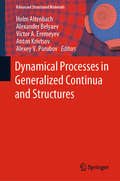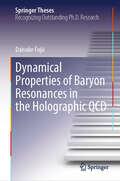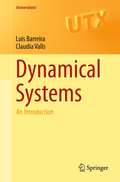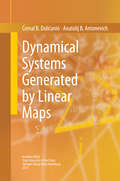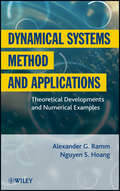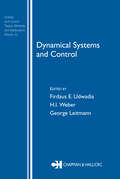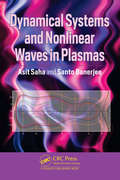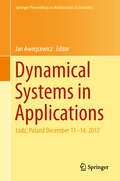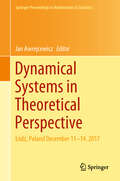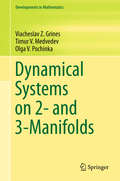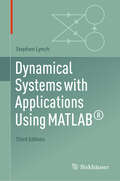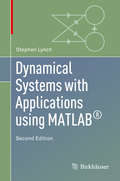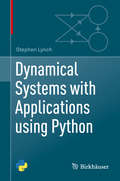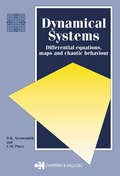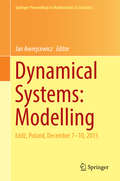- Table View
- List View
Dynamical Processes in Generalized Continua and Structures (Advanced Structured Materials #103)
by Holm Altenbach Victor A. Eremeyev Anton Krivtsov Alexander Belyaev Alexey V. PorubovThis book presents a collection of chapters on the current problems of the theory of dynamical processes in generalized continua and structures, and has been compiled to commemorate the 70th birthday of Prof. Dmitry Indeitsev – a leading specialist in the field of dynamical processes in solids, fluids and structures. It discusses various applications related to Prof. Indeitsev’s contributions, including various discrete and continuous dynamic models of structures and media, as well as a number of dynamical processes in generalized media.
Dynamical Processes on Complex Networks
by Alain Barrat Marc Barthélemy Alessandro VespignaniThe availability of large data sets have allowed researchers to uncover complex properties such as large scale fluctuations and heterogeneities in many networks which have lead to the breakdown of standard theoretical frameworks and models. Until recently these systems were considered as haphazard sets of points and connections. Recent advances have generated a vigorous research effort in understanding the effect of complex connectivity patterns on dynamical phenomena. For example, a vast number of everyday systems, from the brain to ecosystems, power grids and the Internet, can be represented as large complex networks. This new and recent account presents a comprehensive explanation of these effects.
Dynamical Processes on Complex Networks
by Alain Barrat Marc Barthélemy Alessandro VespignaniThe availability of large data sets have allowed researchers to uncover complex properties such as large scale fluctuations and heterogeneities in many networks which have lead to the breakdown of standard theoretical frameworks and models. Until recently these systems were considered as haphazard sets of points and connections. Recent advances have generated a vigorous research effort in understanding the effect of complex connectivity patterns on dynamical phenomena. For example, a vast number of everyday systems, from the brain to ecosystems, power grids and the Internet, can be represented as large complex networks. This new and recent account presents a comprehensive explanation of these effects.
Dynamical Properties of Baryon Resonances in the Holographic QCD (Springer Theses)
by Daisuke FujiiThis book focuses on the study of the dynamical properties of hadron resonances, especially their transition processes by electromagnetic and strong interactions, by using the holographic quantum chromodynamics (QCD) model. Understanding the nature of hadrons leads to revealing non-perturbative phenomena that are prominent in the low-energy region of QCD. However, there remain many open questions regarding the nature of resonant states. Holographic QCD is one of the most powerful methods to elucidate non-perturbative phenomena in QCD. We will attempt to investigate the dynamical properties of hadron resonances using the Sakai-Sugimoto model, which has achieved much success in the study of hadron physics. In particular, we studied the transition process of hadrons through the calculation of the form factors of them employing the approach of holographic QCD. The book contains a systematic review of the treatment of hadron physics by the Sakai-Sugimoto model. It further covers how to calculate the form factors of baryons through the calculation of the n-point function from holographic QCD. It also includes remarks on the modern understanding of hadron physics. The method of collective coordinate quantization of solitons—Skyrmion and Instanton—is also explained in a concise manner. These are useful not only for students and young researchers interested in this field.
Dynamical System Synchronization
by Albert C. LuoDynamical System Synchronization (DSS) meticulously presents for the first time the theory of dynamical systems synchronization based on the local singularity theory of discontinuous dynamical systems. The book details the sufficient and necessary conditions for dynamical systems synchronizations, through extensive mathematical expression. Techniques for engineering implementation of DSS are clearly presented compared with the existing techniques.
Dynamical System and Chaos: An Introduction with Applications (UNITEXT for Physics)
by Rui DilãoThis textbook introduces the language and the techniques of the theory of dynamical systems of finite dimension for an audience of physicists, engineers, and mathematicians at the beginning of graduation. Author addresses geometric, measure, and computational aspects of the theory of dynamical systems. Some freedom is used in the more formal aspects, using only proofs when there is an algorithmic advantage or because a result is simple and powerful. The first part is an introductory course on dynamical systems theory. It can be taught at the master's level during one semester, not requiring specialized mathematical training. In the second part, the author describes some applications of the theory of dynamical systems. Topics often appear in modern dynamical systems and complexity theories, such as singular perturbation theory, delayed equations, cellular automata, fractal sets, maps of the complex plane, and stochastic iterations of function systems are briefly explored for advanced students. The author also explores applications in mechanics, electromagnetism, celestial mechanics, nonlinear control theory, and macroeconomy. A set of problems consolidating the knowledge of the different subjects, including more elaborated exercises, are provided for all chapters.
Dynamical Systems
by Luis Barreira Claudia VallsThe theory of dynamical systems is a broad and active research subject with connections to most parts of mathematics. Dynamical Systems: An Introduction undertakes the difficult task to provide a self-contained and compact introduction. Topics covered include topological, low-dimensional, hyperbolic and symbolic dynamics, as well as a brief introduction to ergodic theory. In particular, the authors consider topological recurrence, topological entropy, homeomorphisms and diffeomorphisms of the circle, Sharkovski's ordering, the Poincaré-Bendixson theory, and the construction of stable manifolds, as well as an introduction to geodesic flows and the study of hyperbolicity (the latter is often absent in a first introduction). Moreover, the authors introduce the basics of symbolic dynamics, the construction of symbolic codings, invariant measures, Poincaré's recurrence theorem and Birkhoff's ergodic theorem. The exposition is mathematically rigorous, concise and direct: all statements (except for some results from other areas) are proven. At the same time, the text illustrates the theory with many examples and 140 exercises of variable levels of difficulty. The only prerequisites are a background in linear algebra, analysis and elementary topology. This is a textbook primarily designed for a one-semester or two-semesters course at the advanced undergraduate or beginning graduate levels. It can also be used for self-study and as a starting point for more advanced topics.
Dynamical Systems
by Shlomo SternbergCelebrated mathematician Shlomo Sternberg, a pioneer in the field of dynamical systems, created this modern one-semester introduction to the subject for his classes at Harvard University. Its wide-ranging treatment covers one-dimensional dynamics, differential equations, random walks, iterated function systems, symbolic dynamics, and Markov chains. Supplementary materials offer a variety of online components, including PowerPoint lecture slides for professors and MATLAB exercises."Even though there are many dynamical systems books on the market, this book is bound to become a classic. The theory is explained with attractive stories illustrating the theory of dynamical systems, such as the Newton method, the Feigenbaum renormalization picture, fractal geometry, the Perron-Frobenius mechanism, and Google PageRank." -- Oliver Knill, PhD, Preceptor of Mathematics, Harvard University.
Dynamical Systems Generated by Linear Maps
by Ćemal B. Dolićanin Anatolij B. AntonevichThe book deals with dynamical systems, generated by linear mappings of finite dimensional spaces and their applications. These systems have a relatively simple structure from the point of view of the modern dynamical systems theory. However, for the dynamical systems of this sort, it is possible to obtain explicit answers to specific questions being useful in applications. The considered problems are natural and look rather simple, but in reality in the course of investigation, they confront users with plenty of subtle questions and their detailed analysis needs a substantial effort. The problems arising are related to linear algebra and dynamical systems theory, and therefore, the book can be considered as a natural amplification, refinement and supplement to linear algebra and dynamical systems theory textbooks.
Dynamical Systems Method and Applications: Theoretical Developments and Numerical Examples
by Alexander G. Ramm Nguyen S. HoangDemonstrates the application of DSM to solve a broad range of operator equations The dynamical systems method (DSM) is a powerful computational method for solving operator equations. With this book as their guide, readers will master the application of DSM to solve a variety of linear and nonlinear problems as well as ill-posed and well-posed problems. The authors offer a clear, step-by-step, systematic development of DSM that enables readers to grasp the method's underlying logic and its numerous applications. Dynamical Systems Method and Applications begins with a general introduction and then sets forth the scope of DSM in Part One. Part Two introduces the discrepancy principle, and Part Three offers examples of numerical applications of DSM to solve a broad range of problems in science and engineering. Additional featured topics include: General nonlinear operator equations Operators satisfying a spectral assumption Newton-type methods without inversion of the derivative Numerical problems arising in applications Stable numerical differentiation Stable solution to ill-conditioned linear algebraic systems Throughout the chapters, the authors employ the use of figures and tables to help readers grasp and apply new concepts. Numerical examples offer original theoretical results based on the solution of practical problems involving ill-conditioned linear algebraic systems, and stable differentiation of noisy data. Written by internationally recognized authorities on the topic, Dynamical Systems Method and Applications is an excellent book for courses on numerical analysis, dynamical systems, operator theory, and applied mathematics at the graduate level. The book also serves as a valuable resource for professionals in the fields of mathematics, physics, and engineering.
Dynamical Systems and Control (Stability and Control: Theory, Methods and Applications)
by George Leitmann Firdaus E. Udwadia H. I. WeberThe 11th International Workshop on Dynamics and Control brought together scientists and engineers from diverse fields and gave them a venue to develop a greater understanding of this discipline and how it relates to many areas in science, engineering, economics, and biology. The event gave researchers an opportunity to investigate ideas and techniq
Dynamical Systems and Methods
by Albert C. Luo José António Machado Dumitru BaleanuNonlinear Systems and Methods For Mechanical, Electrical and Biosystems presents topics observed at the 3rd Conference on Nonlinear Science and Complexity(NSC), focusing on energy transfer and synchronization in hybrid nonlinear systems. The studies focus on fundamental theories and principles,analytical and symbolic approaches, computational techniques in nonlinear physical science and mathematics. Broken into three parts, the text covers: Parametrical excited pendulum, nonlinear dynamics in hybrid systems, dynamical system synchronization and (N+1) body dynamics as well as new views different from the existing results in nonlinear dynamics, mathematical methods for dynamical systems including conservation laws, dynamical symmetry in nonlinear differential equations and invex energies and nonlinear phenomena in physical problems such as solutions, complex flows, chemical kinetics, Toda lattices and parallel manipulator. This book is useful to scholars, researchers and advanced technical members of industrial laboratory facilities developing new tools and products.
Dynamical Systems and Nonlinear Waves in Plasmas
by Santo Banerjee Asit SahaDynamical systems and Nonlinear Waves in Plasmas is written in a clear and comprehensible style to serve as a compact volume for advanced postgraduate students and researchers working in the areas of Applied Physics, Applied Mathematics, Dynamical Systems, Nonlinear waves in Plasmas or other nonlinear media. It provides an introduction to the background of dynamical systems, waves, oscillations and plasmas. Basic concepts of dynamical systems and phase plane analysis for the study of dynamical properties of nonlinear waves in plasmas are presented. Different kinds of waves in plasmas are introduced. Reductive perturbative technique and its applications to derive different kinds of nonlinear evolution equations in plasmas are discussed. Analytical wave solutions of these nonlinear evolution equations are presented using the concept of bifurcation theory of planar dynamical systems in a very simple way. Bifurcations of both small and arbitrary amplitudes of various nonlinear acoustic waves in plasmas are presented using phase plots and time-series plots. Super nonlinear waves and its bifurcation behaviour are discussed for various plasma systems. Multiperiodic, quasiperiodic and chaotic motions of nonlinear plasma waves are discussed in presence of external periodic force. Multistability of plasma waves is investigated. Stable oscillation of plasma waves is also presented in dissipative plasmas. The book is meant for undergraduate and postgraduate students studying plasma physics. It will also serve a reference to the researchers, scientists and faculties to pursue the dynamics of nonlinear waves and its properties in plasmas. It describes the concept of dynamical systems and is useful in understanding exciting features, such as solitary wave, periodic wave, supernonlinear wave, chaotic, quasiperiodic and coexisting structures of nonlinear waves in plasmas. The concepts and approaches, discussed in the book, will also help the students and professionals to study such features in other nonlinear media.
Dynamical Systems for Biological Modeling: An Introduction (Advances in Applied Mathematics)
by Fred Brauer Christopher KribsDynamical Systems for Biological Modeling: An Introduction prepares both biology and mathematics students with the understanding and techniques necessary to undertake basic modeling of biological systems. It achieves this through the development and analysis of dynamical systems.The approach emphasizes qualitative ideas rather than explicit computa
Dynamical Systems in Applications: Poland December 11 -14 2017 (Springer Proceedings in Mathematics & Statistics #249)
by Jan AwrejcewiczThe book is intended for all those who are interested in application problems related to dynamical systems. It provides an overview of recent findings on dynamical systems in the broadest sense. Divided into 46 contributed chapters, it addresses a diverse range of problems. The issues discussed include: Finite Element Analysis of optomechatronic choppers with rotational shafts; computational based constrained dynamics generation for a model of a crane with compliant support; model of a kinetic energy recuperation system for city buses; energy accumulation in mechanical resonance; hysteretic properties of shell dampers; modeling a water hammer with quasi-steady and unsteady friction in viscoelastic conduits; application of time-frequency methods for the assessment of gas metal arc welding conditions; non-linear modeling of the human body’s dynamic load; experimental evaluation of mathematical and artificial neural network modeling for energy storage systems; interaction of bridge cables and wake in vortex-induced vibrations; and the Sommerfeld effect in a single DOF spring-mass-damper system with non-ideal excitation.
Dynamical Systems in Theoretical Perspective: Poland December 11 -14 2017 (Springer Proceedings in Mathematics & Statistics #248)
by Jan AwrejcewiczThis book focuses on theoretical aspects of dynamical systems in the broadest sense. It highlights novel and relevant results on mathematical and numerical problems that can be found in the fields of applied mathematics, physics, mechanics, engineering and the life sciences. The book consists of contributed research chapters addressing a diverse range of problems. The issues discussed include (among others): numerical-analytical algorithms for nonlinear optimal control problems on a large time interval; gravity waves in a reservoir with an uneven bottom; value distribution and growth of solutions for certain Painlevé equations; optimal control of hybrid systems with sliding modes; a mathematical model of the two types of atrioventricular nodal reentrant tachycardia; non-conservative instability of cantilevered nanotubes using the Cell Discretization Method; dynamic analysis of a compliant tensegrity structure for use in a gripper application; and Jeffcott rotor bifurcation behavior using various models of hydrodynamic bearings.
Dynamical Systems on 2- and 3-Manifolds
by Viacheslav Z. Grines Timur V. Medvedev Olga V. PochinkaThis book provides an introduction to the topological classification of smooth structurally stable diffeomorphisms on closed orientable 2- and 3-manifolds. The topological classification is one of the main problems of the theory of dynamical systems and the results presented in this book are mostly for dynamical systems satisfying Smale's Axiom A. The main results on the topological classification of discrete dynamical systems are widely scattered among many papers and surveys. This book presents these results fluidly, systematically, and for the first time in one publication. Additionally, this book discusses the recent results on the topological classification of Axiom A diffeomorphisms focusing on the nontrivial effects of the dynamical systems on 2- and 3-manifolds. The classical methods and approaches which are considered to be promising for the further research are also discussed. The reader needs to be familiar with the basic concepts of the qualitative theory of dynamical systems which are presented in Part 1 for convenience. The book is accessible to ambitious undergraduates, graduates, and researchers in dynamical systems and low dimensional topology. This volume consists of 10 chapters; each chapter contains its own set of references and a section on further reading. Proofs are presented with the exact statements of the results. In Chapter 10 the authors briefly state the necessary definitions and results from algebra, geometry and topology. When stating ancillary results at the beginning of each part, the authors refer to other sources which are readily available.
Dynamical Systems on Networks
by Mason A. Porter James P. GleesonThis volume is a tutorial for the study of dynamical systems on networks. It discusses both methodology and models, including spreading models for social and biological contagions. The authors focus especially on "simple" situations that are analytically tractable, because they are insightful and provide useful springboards for the study of more complicated scenarios. This tutorial, which also includes key pointers to the literature, should be helpful for junior and senior undergraduate students, graduate students, and researchers from mathematics, physics, and engineering who seek to study dynamical systems on networks but who may not have prior experience with graph theory or networks. Mason A. Porter is Professor of Nonlinear and Complex Systems at the Oxford Centre for Industrial and Applied Mathematics, Mathematical Institute, University of Oxford, UK. He is also a member of the CABDyN Complexity Centre and a Tutorial Fellow of Somerville College. James P. Gleeson is Professor of Industrial and Applied Mathematics, and co-Director of MACSI, at the University of Limerick, Ireland.
Dynamical Systems with Applications Using MATLAB®
by Stephen LynchThis textbook, now in its third edition, provides a broad and accessible introduction to both continuous and discrete dynamical systems, the theory of which is motivated by examples from a wide range of disciplines. It emphasizes applications and simulation utilizing MATLAB®, Simulink®, the Image Processing Toolbox®, the Symbolic Math Toolbox®, and the Deep Learning Toolbox®. The text begins with a tutorial introduction to MATLAB that assumes no prior programming knowledge. Discrete systems are covered in the first part, after which the second part explores the study of continuous systems using delay, ordinary, and partial differential equations. The third part considers chaos control and synchronization, binary oscillator computing, Simulink, and the Deep Learning Toolbox. A final chapter provides examination- and coursework-type MATLAB questions for use by instructors and students. For the Third Edition, all the material has been thoroughly updated in line with the most recent version of MATLAB, R2025a. New chapters have been added on artificial neural networks, delay differential equations, numerical methods for ordinary and partial differential equations, and the Deep Learning Toolbox. MATLAB program files, Simulink model files, and other materials are available to download from the author&’s website and through GitHub. The hands-on approach of Dynamical Systems with Applications using MATLAB® has minimal prerequisites, only requiring familiarity with ordinary differential equations. It will appeal to advanced undergraduate and graduate students, applied mathematicians, engineers, and researchers in a broad range of disciplines such as population dynamics, biology, chemistry, computing, economics, nonlinear optics, neural networks, and physics. Praise for the Second Edition: &“This book [is] a valuable reference to the existing literature on dynamical systems, especially for the remarkable collection of examples and applications selected from very different areas, as well as for its treatment with MATLAB of these problems.&” -- Fernando Casas, zbMATH &“[The] vast compilation of applications makes this text a great resource for applied mathematicians, engineers, physicists, and researchers. Instructors will be pleased to find an aims and objectives section at the beginning of each chapter where the author outlines its content and provides student learning objectives.&” -- Stanley R. Huddy, MAA Reviews
Dynamical Systems with Applications Using Mathematica®
by Stephen LynchThis book provides an introduction to the theory of dynamical systems with the aid of the Mathematica(R) computer algebra package. The book has a very hands-on approach and takes the reader from basic theory to recently published research material. Emphasized throughout are numerous applications to biology, chemical kinetics, economics, electronics, epidemiology, nonlinear optics, mechanics, population dynamics, and neural networks. Theorems and proofs are kept to a minimum. The first section deals with continuous systems using ordinary differential equations, while the second part is devoted to the study of discrete dynamical systems.
Dynamical Systems with Applications using MATLAB®
by Stephen LynchThis textbook, now in its second edition, provides a broad introduction to both continuous and discrete dynamical systems, the theory of which is motivated by examples from a wide range of disciplines. It emphasizes applications and simulation utilizing MATLAB®, Simulink®, the Image Processing Toolbox® and the Symbolic Math toolbox®, including MuPAD. Features new to the second edition include · sections on series solutions of ordinary differential equations, perturbation methods, normal forms, Gröbner bases, and chaos synchronization; · chapters on image processing and binary oscillator computing; · hundreds of new illustrations, examples, and exercises with solutions; and · over eighty up-to-date MATLAB program files and Simulink model files available online. These files were voted MATLAB Central Pick of the Week in July 2013. The hands-on approach of Dynamical Systems with Applications using MATLAB, Second Edition, has minimal prerequisites, only requiring familiarity with ordinary differential equations. It will appeal to advanced undergraduate and graduate students, applied mathematicians, engineers, and researchers in a broad range of disciplines such as population dynamics, biology, chemistry, computing, economics, nonlinear optics, neural networks, and physics. Praise for the first edition Summing up, it can be said that this text allows the reader to have an easy and quick start to the huge field of dynamical systems theory. MATLAB/SIMULINK facilitate this approach under the aspect of learning by doing. --OR News/Operations Research Spectrum The MATLAB programs are kept as simple as possible and the author's experience has shown that this method of teaching using MATLAB works well with computer laboratory classes of small sizes. . . . I recommend 'Dynamical Systems with Applications using MATLAB' as a good handbook for a diverse readership: graduates and professionals in mathematics, physics, science and engineering. --Mathematica
Dynamical Systems with Applications using Python
by Stephen LynchThis textbook provides a broad introduction to continuous and discrete dynamical systems. With its hands-on approach, the text leads the reader from basic theory to recently published research material in nonlinear ordinary differential equations, nonlinear optics, multifractals, neural networks, and binary oscillator computing. Dynamical Systems with Applications Using Python takes advantage of Python’s extensive visualization, simulation, and algorithmic tools to study those topics in nonlinear dynamical systems through numerical algorithms and generated diagrams.After a tutorial introduction to Python, the first part of the book deals with continuous systems using differential equations, including both ordinary and delay differential equations. The second part of the book deals with discrete dynamical systems and progresses to the study of both continuous and discrete systems in contexts like chaos control and synchronization, neural networks, and binary oscillator computing. These later sections are useful reference material for undergraduate student projects. The book is rounded off with example coursework to challenge students’ programming abilities and Python-based exam questions. This book will appeal to advanced undergraduate and graduate students, applied mathematicians, engineers, and researchers in a range of disciplines, such as biology, chemistry, computing, economics, and physics. Since it provides a survey of dynamical systems, a familiarity with linear algebra, real and complex analysis, calculus, and ordinary differential equations is necessary, and knowledge of a programming language like C or Java is beneficial but not essential.
Dynamical Systems, Bifurcation Analysis and Applications: Penang, Malaysia, August 6–13, 2018 (Springer Proceedings in Mathematics & Statistics #295)
by Mohd Hafiz Mohd Norazrizal Aswad Abdul Rahman Nur Nadiah Abd Hamid Yazariah Mohd YatimThis book is the result of Southeast Asian Mathematical Society (SEAMS) School 2018 on Dynamical Systems and Bifurcation Analysis (DySBA). It addresses the latest developments in the field of dynamical systems, and highlights the importance of numerical continuation studies in tracking both stable and unstable steady states and bifurcation points to gain better understanding of the dynamics of the systems. The SEAMS School 2018 on DySBA was held in Penang from 6th to 13th August at the School of Mathematical Sciences, Universiti Sains Malaysia.The SEAMS Schools are part of series of intensive study programs that aim to provide opportunities for an advanced learning experience in mathematics via planned lectures, contributed talks, and hands-on workshop.This book will appeal to those postgraduates, lecturers and researchers working in the field of dynamical systems and their applications. Senior undergraduates in Mathematics will also find it useful.
Dynamical Systems: Differential Equations, Maps, and Chaotic Behaviour (Chapman Hall/crc Mathematics Ser. #5)
by C.M. PlaceThis text discusses the qualitative properties of dynamical systems including both differential equations and maps. The approach taken relies heavily on examples (supported by extensive exercises, hints to solutions and diagrams) to develop the material, including a treatment of chaotic behavior.The unprecedented popular interest shown in recent years in the chaotic behavior of discrete dynamic systems including such topics as chaos and fractals has had its impact on the undergraduate and graduate curriculum. However there has, until now, been no text which sets out this developing area of mathematics within the context of standard teaching of ordinary differential equations.Applications in physics, engineering, and geology are considered and introductions to fractal imaging and cellular automata are given.
Dynamical Systems: Modelling
by Jan AwrejcewiczThe book is a collection of contributions devoted to analytical, numerical and experimental techniques of dynamical systems, presented at the international conference "Dynamical Systems: Theory and Applications," held in Å ódź, Poland on December 7-10, 2015. The studies give deep insight into new perspectives in analysis, simulation, and optimization of dynamical systems, emphasizing directions for future research. Broadly outlined topics covered include: bifurcation and chaos in dynamical systems, asymptotic methods in nonlinear dynamics, dynamics in life sciences and bioengineering, original numerical methods of vibration analysis, control in dynamical systems, stability of dynamical systems, vibrations of lumped and continuous systems, non-smooth systems, engineering systems and differential equations, mathematical approaches to dynamical systems, and mechatronics.
